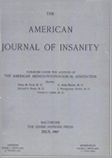STATISTICAL CONTRIBUTIONS FROM THE MENTAL HYGIENE STUDY OF THE EASTERN HEALTH DISTRICT OF BALTIMORE
Abstract
1. The rate of first admissions of psychotics to hospitals for mental disease from the Eastern Health District in 1933 is 17.5.0 per 100,000 of the population 15 years of age and over. The race and sex specific rates are: white males, 172.3; white females, 138.9; negro males, 376.0; negro females, 137.9. The negro male rate is significantly different from the others, and the difference seems to be due to an exceptionally high proportion of syphilitic psychosis in that group.
2. The average rates of first admissions per year, for the years 1933 to 1936 inclusive are: white males, 161.2; white females, 116.2; negro males, 250.7; negro females, 143.6.
3. The prevalence of psychosis in the district in 1933, as measured by all discoverable cases who could be allocated to the district, is 818.4 per 100,000 of the population 15 years of age and over.
The race and sex specific rates are: white males, 874.4; white females, 875.7; negro males, 827.3; negro females, 390.7. The relative deficiency of negro females cannot be explained.
4. The two wards of the district differ appreciably in prevalence of psychosis. The rates are:
5. The differences between the two wards are not associated with differences in age composition of the populations of the two wards. No explanation for the differences has yet been discovered, but the general fact appears to be one of importance to psychiatry.
Access content
To read the fulltext, please use one of the options below to sign in or purchase access.- Personal login
- Institutional Login
- Sign in via OpenAthens
- Register for access
-
Please login/register if you wish to pair your device and check access availability.
Not a subscriber?
PsychiatryOnline subscription options offer access to the DSM-5 library, books, journals, CME, and patient resources. This all-in-one virtual library provides psychiatrists and mental health professionals with key resources for diagnosis, treatment, research, and professional development.
Need more help? PsychiatryOnline Customer Service may be reached by emailing [email protected] or by calling 800-368-5777 (in the U.S.) or 703-907-7322 (outside the U.S.).



